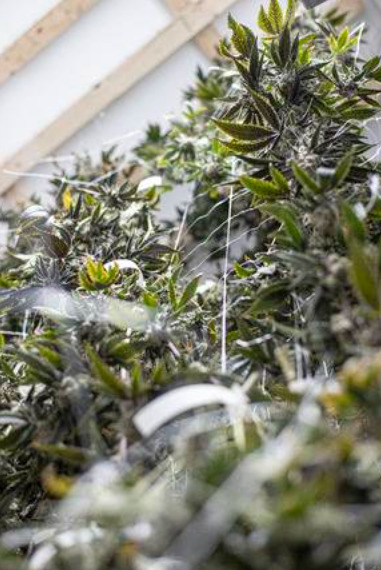Cannabis cultivation, especially in confined or discreet places, are often tricky. The same goes with preparing joints over modern glow led trays, lighting and space are important. The more plants you would like to grow, the more space you will need. Vertical growth is where plants rise on tiered shelves around or aligned straight upwards.
Vertical cannabis growing has been known to quite double the quantity of space available for cultivation compared to horizontal growing. Multiple shelves are often stacked during a square or hexagon around a central light. Plants can produce impressive yields when appropriately arranged in these conditions.
They will be stacked on shelves or arranged with trellises and strings. These setups take up less space for growing, allowing you to potentially raise more plants. It also reduces your energy bill alongside the environmental impact of indoor growing.
The Central Light Will Get To Be Kept Cool
The most important thing in growing marijuana is lighting. This may be easiest to manage with energy-efficient LED lights. A cooling fan under the interior light should dissipate heat upward. Wherever you’re doing this, proper ventilation may be a given.
As your plants grow, make sure to trim unproductive parts. You’ll also use the string grids of screen setups to shape the expansion of plants. You would like an even pleasing shape to your plant. Make sure to rotate your crops so that all sides get an equal amount of your time facing the inner light.

Vertical Cannabis Growing Makes The Foremost Of Obtainable Space
Imagine for a flash a whole warehouse floor covered during a horizontally grown cannabis crop with large lights hanging overhead. Now, imagine instead a complete warehouse crammed with towering racks stacked side by side, wall to wall. Each side of every frame is covered in cannabis plants, and between each shelf sits an outsized light.
This simple visualization is an example of what proportion more cannabis is often grown within an equivalent space using vertical growing techniques. An equivalent logic also can be applied to small grow-ops. Imagine a closet with one cannabis plant sitting under a light-weight. Now, imagine installing a rack onto the most important wall up the cabinet, growing multiple plants upon it, and placing the sunshine within the middle of the space instead.
Plan and Start Planting
One of the best things to think about before installing a vertical system in your grow room is the indisputable fact that this technique is meant to possess tons of plants in it. This is often not really a system for smaller growing operations. To maximize the potential of this technique is by really stacking the plants up from the bottom to the roof. So what about all the additional plants? It’s essential to think about your growing location, and whether you’re going to find yourself in trouble for having over 100 plants in your grow room!
This process could be a touch bit more tedious at the start because it’ll also mean that you simply need more mother plants. Having more plants means having more mother plants, so it’s essential to think about where they’re getting to live and, therefore, space and electricity required for these, too. It’s also time-consuming to refill your vertical growing system with the plants from the cuttings.
The True Vertical
As sprawling commercial cannabis cultivation facilities happen across North America, there’s no denying these facilities are expensive operations. From the vital estate required to massive energy bills and significant staffing requirements, maintaining and growing cannabis isn’t cheap. Maximizing space and reducing operating costs is of utmost importance to most commercial cannabis growers. As such, single-level, horizontal farming rooms are waning as operators look for ways to enhance yields, cut costs, and improve efficiencies.
An accurate vertical operation takes the thought of upright cultivation to an entirely new level. Vertical growing may be a concept that literally flips the traditional wisdom of farming, on its head. There are many iterations of what a vertical operation can appear as if, but the principles of vertical farms specialize in space-savings, energy efficiency, and increased yields. Counting on crop and specifically found out, an upright design can do 70 to 90 percent water efficiency over horizontal grows and boost canopy space eight times over.
Vertical growing options for cannabis farms are evolving. From aeroponics to hydroponics to soil, cannabis producers are arising with innovative solutions to “grow up” rather than out.
Hydroponic Vertical Farming – Stem Cultivation
Hydroponic systems use another growing medium like mineral wool, coconut husks, or clay pellets. Not all hydroponic solutions are suitable for all kinds of vertical operations. Still, the concept revolves around removing the soil from the equation and to supply the plant’s rootage with direct access to a water-based nutrient mixture. Water resources are effectively targeting the plants, and water is recycled back to the system for reuse.
A hydroponic vertical found out improves profitability and reduces resource waste. Nutrient Film Technique (NFT) and Hydroponic Stairs are two systems that transition well into a vertical farming solution.
By employing an exact vertical method precisely fed by closed-loop hydroponics, Cultivation’s all-inclusive platform claims to consistently yield quite 5 times the grams per square feet of land for a fraction of the start-up and ongoing operating expenses of an indoor grow operation with an identical footprint.
Further, plant boxes exceed virtually every efficiency metric employed by growers, including grams/watt; watts/sq. ft. (canopy); grams/kWh/sq. ft. (real estate); and cost/pound. Altogether, the cultivation helps any grower can lower costs, sell for higher margins, and remain competitive when prices inevitably fall.
Visualizing Vertical Cultivation
This can be a harsh imagine learning a whole indoor grow, flipping it 90 degrees, and layering it onto the wall. Now, imagine a concept to visualize; positioning the pots 45 degrees horizontally, the plants can grow slightly outwards and upwards. This is often the essential idea behind vertical growth. During this setup, the sunshine source is targeting multiple planes of growth simultaneously rather than only one. During this setup, cannabis takes on a vine-like form.
Horizontal growing is undoubtedly an efficient method; hence, it’s been used for many years to supply a number of the best indoor weeds the planet has ever witnessed. However, this manner of growing may soon become a thing of the past, especially for large-scale commercial operations that would much enjoy harvesting larger yields within the same amount of space.
Bottom Line
Many ask stacked growing systems as vertical growing solutions. The standard stacked system is actually a horizontal farm, replicated, and placed on a secondary level. This new level still requires a separate lighting source, the staff to take care of it, and usually some mechanics to maneuver or rotate the plants right down to a level where growers can easily reach the plants.
Soil-based and hydroponics systems are the foremost accessible sorts of indoor stacked farming options. Setups are typically a series of automatic shelving units, with two to 3 vertical rows of plants. While these sorts of stacked systems improve the yield per sq ft averages, they typically don’t do anything to reduce costs. In fact, stacked arrangements may increase production costs due to the duplication of kit and resources necessary for every level of cultivation.
With vertical farming techniques and equipment, cannabis growers are pushing the boundaries of innovation upwards, and into the realms of vertical growing. Whether the tactic requires soil, hydroponics, or aeroponics, vertical growing operations can help cultivators expand its operation without expanding its footprint.





